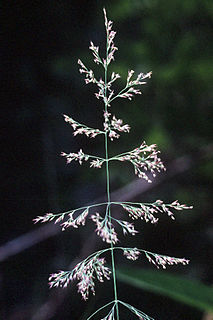
Calamagrostis is a genus in the grass family Poaceae, with about 260 species that occur mainly in temperate regions of the globe. Towards equatorial latitudes, species of Calamagrostis generally occur at higher elevations. These tufted perennials usually have hairless narrow leaves. The ligules are usually blunt. The inflorescence forms a panicle. Some may be reed-like.

Ornamental grasses are grasses grown as ornamental plants. They have become increasingly popular in gardens in recent years. Ornamental grasses are popular in many colder hardiness zones for their resilience to cold temperatures and aesthetic value throughout fall and winter seasons.
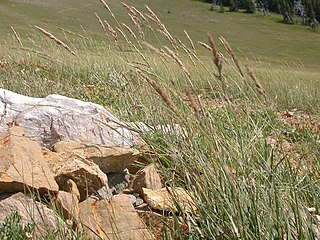
Calamagrostis purpurascens, variously known by the common names purple reedgrass, purple pinegrass, or alpine reedgrass is a perennial grass, growing 30 to 70 centimetres (28 in) tall.
Calamagrostis expansa is a species of grass in the Poaceae family known by the common name Maui reedgrass. It is native to Hawaii, where it is known only from Maui and the island of Hawaiʻi. Its natural habitats are lowland moist forests and swamps. It is threatened by habitat loss.

Calamagrostis hillebrandii is a species of grass in the family Poaceae known commonly as Hillebrand's reedgrass. It is endemic to Maui in Hawaii, where there are only two known subpopulations with a total of perhaps 500 individuals. This is a federally listed endangered species of the United States.
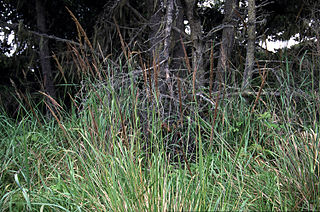
Calamagrostis nutkaensis is a species of grass known by the common names Pacific reedgrass and Nootka reedgrass.

Tussock grasses or bunch grasses are a group of grass species in the Poaceae family. They usually grow as singular plants in clumps, tufts, hummocks, or bunches, rather than forming a sod or lawn, in meadows, grasslands, and prairies. As perennial plants, most species live more than one season. Tussock grasses are often found as forage in pastures and ornamental grasses in gardens.

Calamagrostis canadensis is a species of grass, having three or more varieties, in the Poaceae family. It is known variously by the common names of bluejoint, bluejoint reedgrass, marsh reedgrass, Canadian reedgrass, meadow pinegrass, and marsh pinegrass.

Calamagrostis bolanderi is a species of grass known by the common name Bolander's reedgrass.

Calamagrostis breweri is a species of grass known by the common name shorthair reedgrass.

Calamagrostis foliosa is a species of grass known by the common name leafy reedgrass.

Calamagrostis koelerioides, fire reedgrass, is a species of grass native to western North America in the United States. It ranges from western Wyoming to Washington state, south to Mexico. It is found in many habitat types.

Calamagrostis ophitidis, serpentine reedgrass, is a species of bunch grass in the Poaceae family.
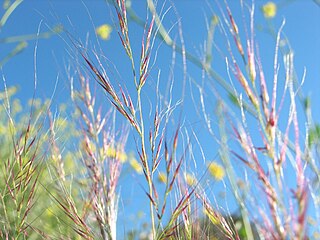
Vulpia microstachys is a species of grass known by the common names small fescue and small sixweeks grass. It is native to western North America from British Columbia to Colorado and New Mexico to Baja California, where it grows in many types of open habitat, including grasslands. It is dominant on some grasslands of California, and it was probably an abundant native grass before the habitat was altered by invasive non-native grasses. It occurs on serpentine soils with associates such as serpentine reedgrass. It is also known from parts of South America. It is an annual grass producing one stem or a clump of several stems growing up to 75 centimeters tall. The inflorescence has several open branches bearing clusters of purple-tinged spikelets. The spikelet has 1 to 6 flowers. The grass is usually cleistogamous, its flowers fertilizing themselves.
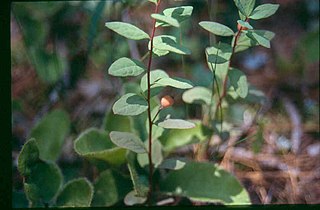
Geocaulon is a monotypic genus of flowering plants in the family Santalaceae containing the single species Geocaulon lividum, which is known by the common names northern comandra and false toadflax. It is native to northern North America, where it is common and widespread from Alaska to Newfoundland and into the northernmost contiguous United States.

Calamagrostis montanensis is a species of grass known by the common names plains reedgrass and prairie reedgrass. It is native to North America, where it is found across Canada from British Columbia to Manitoba and south to Colorado in the United States.

Carex saxatilis is a species of sedge known by the common names rock sedge and russet sedge. It has a circumboreal distribution, occurring throughout the northern latitudes of the Northern Hemisphere. It occurs in Alaska, throughout most all of Canada to Greenland and in Eurasia. In North America it occurs at high elevations as far south as Utah and Colorado.
Leymus innovatus is a species of grass known by the common names downy ryegrass, boreal wildrye, hairy wildrye, fuzzyspike wildrye, northern wildrye, and northwestern wildrye. It is native to northern North America from Alaska to eastern Canada and south to South Dakota.
Calamagrostis lapponica, the Lappland reedgrass, is a grass species native to colder parts of the Northern Hemisphere. It has been reported from Scandinavia, Russia, Greenland, Alaska, and every Canadian province and territory except the Maritime Provinces.














